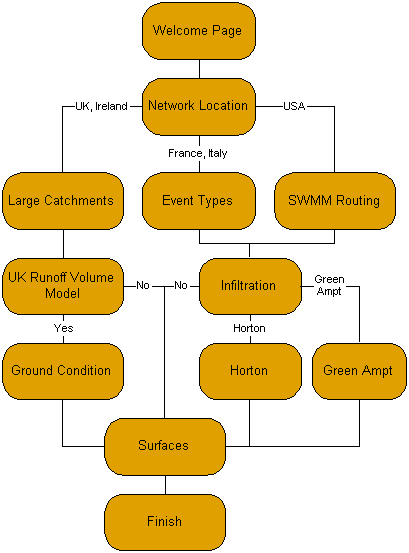The Runoff Surface Wizard provides a structured way to create new Runoff Surfaces. After you enter your chosen parameters, the Wizard will generate three surfaces based on the parameters you have entered:
- impervious (road)
- impervious (roof)
- pervious
The Runoff Surface Wizard is displayed when you choose Runoff surface wizard from the Model menu.
Using the Wizard
The Wizard is most appropriate for UK catchments, which use the three standard surfaces listed above. You can also use it for other areas where these three surface types are used. You can also make adjustments and add additional surfaces after using the wizard.
The Wizard will offer to replace the default surfaces, numbered 10, 20, and 21. These defaults go back to previous packages like HydroWorks and WALLRUS and are well known to UK users.
You can choose to replace different surfaces by entering different Surface IDs, or add new surfaces by entering Surface IDs that are not yet used.
When you have created your three surfaces, you should set up one or more Land Use Definitions that use the new surfaces as Runoff Surfaces 1, 2 and 3.
The image below shows the structure of pages in the Runoff Surface Wizard. When you click the Next button, you will move down through the structure. If the next page depends on a choice you make, the choices are marked on the links between boxes. Clicking Back will move you back up to the point you came from.
Click on one of the boxes to get help specific to that page.

Runoff Surface Wizard structure
There is a full description of all the data fields needed to define a surface in Runoff Surface Data Fields.
For more information about surfaces, see Runoff Surfaces.
Location Page
Choose the location of the catchment. This sets options for your choice of Routing Model. The choices are:
|
United Kingdom and Ireland |
Wallingford Procedure Model |
|
France, Italy |
|
|
United States |
Event Types Page
The catchment is in France or Italy, or some other location where one of these two Routing Models is appropriate.
You must choose the type of event you are modelling.
|
Distinct Rainfall Subevents |
Choose this option if your data is divided into distinct sub-events and you have Length information for your subcatchments. The Length data is entered in the Dimension field for each subcatchment. This option uses the full Desbordes Model. |
|
Continuous Rainfall Data |
Choose this option if you do not meet the requirements for the Desbordes Model. This option uses the SPRINT Model, which is a cut down version of the Desbordes Model. |
SWMM Routing Page
The SWMM routing model from the US Environment Protection Agency uses a roughness value for pervious and impervious surfaces, along with a value for Catchment Width.
The suggested defaults for impervious and pervious roughness are taken from Crawford N.H. and Linsley R.K. (1966).
You need to set the Catchment Width in the Dimension field of your subcatchments.
Large Catchments Page
The catchment is located in the United Kingdom or Ireland, and is suitable for the Wallingford Procedure model.
You should now choose whether to use the:
-
Wallingford Procedure Model - small subcatchments up to 1 hectare
-
Large Contributing Area Model - larger subcatchments up to about 100 hectares
If you choose the Large Contributing Area Model you should set the value of the Dimension field for each subcatchment to represent Catchment Length. This field can be ignored for the Wallingford Model.
UK Runoff Page
You have two choice on this page:
|
Yes |
the surfaces use the New UK PR Model. |
|
No |
the surfaces use the Wallingford Procedure Model. |
Ground Condition Page
If you chose to use the New UK PR Model, you must set a value for ground condition. The options are:
-
Good (75%)
-
Fair (50%)
-
Poor (45%)
The two impervious surfaces created will be given a Runoff Volume Type of Fixed, and a Fixed Runoff Coefficient to give the percentage runoff you selected from the list above.
Infiltration Page
This page allows you to set up infiltration options for the pervious runoff surface. It is used when you have selected the following Routing Models:
You have the option of ignoring infiltration, or using one of these two Runoff Volume models:
You then set the appropriate infiltration parameters on the next page.
Horton Page
On this page, you set the three parameters required by the Horton infiltration model. These are:
-
Initial Infiltration
-
Limiting Infiltration
-
Decay Factor
As an alternative to entering values directly, click on the Soil Group button and choose soil group A, B, C or D on the Soil Group Dialog. The suggested values for your chosen group will then be entered when you click OK.
See Horton infiltration model for more information and suggested values.
Green-Ampt Page
On this page, you set the three parameters required by the Green-Ampt infiltration model. These are:
-
Suction
-
Conductivity
-
Deficit
Follow the link above for suggested values.
Surfaces Page
Choose the location of the catchment. This sets options for your choice of Routing Model. The choices are:
|
United Kingdom and Ireland |
Wallingford Procedure Model |
|
France, Italy |
|
|
United States |
